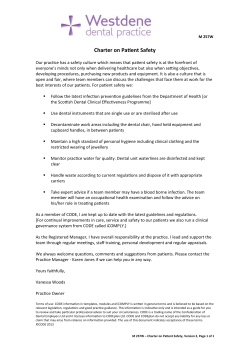
brochure
DENTAL EDUCATION Workshop 3-DIMENSIONAL RADIOGRAPHIC IMAGING Possibilities & Limitations HOW TO RESERVE YOUR PLACE: Contact Karla Uys: Email: info@ascandi.co.uk Tel: 020 8369 6091 DENTAL EDUCATION 3-DIMENSIONAL RADIOGRAPHIC IMAGING Possibilities & Limitations 30th April 2015 6:30 pm – 9:30 pm Hilton London Euston 17-18 Upper Woburn Place | London | WC1H 0HT 2 Hours Verifiable CPD £ 99 T e x VA SPEAKER Michael Bornstein is the head of Radiology and Stomatology at the University of Bern. He graduated from the University of Basel where he also trained in Oral Surgery and Stomatology. He continued his training in Bern and has been a board certified Oral Surgeon since June 2003. In 2004 he was a visiting Assistant Professor at the Department of Periodontics at the University of Texas Health Science Center at San Antonio, USA and in 2009 he completed his habilitation in the field of oral surgery and Stomatology. Fields of Research: Cone beam computed tomography (CBCT) in clinical dental practice, stomatology/oral medicine, GBR procedures and dental implants LECTURE The introduction of cone beam computed tomography (CBCT) has created new diagnostic possibilities in dental medicine. Although computerised tomography (CT) has been available for quite some time, its use in dentistry has always been limited because of cost, access, and radiation. In comparison to CT, CBCT has advantages, the most important being less radiation administered to the patient. CBCT has been established as a valuable imaging technique in many dento-maxillofacial specialties, ranging from oral implant surgery to orthodontics. This lecture will cover basic priniciples of CBCT, and will then focus on indications for CBCT imaging in dental specialities such as oral surgery, orthodontics, endodontics, and implantology. AIMS AND OBJECTIVES •Understand the basic principles of CBCT imaging compared to CT •Learn about the basic principles of radiation protection and dose related risks •K now possible indications of CBCT imaging in oral surgery, endodontics, orthodontics, and oral implantology •Recognise the basics of anatomical versus potentially pathological findings in the jaw region
© Copyright 2025


















